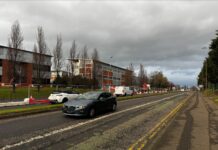
DIRECT employment levels ‘plateaued’ in the second quarter of 2023 among roofing contractors, new research has revealed.
The findings were made in the latest State of the Roofing Industry survey report from NFRC and Glenigan, which also showed that the use of sub-contracted labour during the period only increased ‘very slightly’.
Firms also reported increased difficulty in finding workers with the necessary skills. 46% of respondents said they experienced greater difficulty recruiting suitable labour during the second quarter compared to the previous quarter, against only 6% seeing an improvement in recruitment conditions.
Roof slaters and tilers were in shortest supply (32% reporting a shortage), with 26% saying the same with regards to built-up felt roofers. 15% admitted to struggling to recruit general labourers.
Despite this, labour costs continued to increase, perhaps suggesting that businesses are increasing pay for existing staff and/or sub-contractors.
Concerns in some sectors about near-term pipelines of work reflected an apparent slight fall in enquiry rates for roofing contractors. 22% reported increased enquiries, against 29% seeing a decline. However, workloads continued to grow, with 38% of firms reporting an increase in workloads and just 20% seeing a decline.
Enquiry levels varied by sector, with residential new build work said to be ‘notably’ seeing a decline. Commercial repair, maintenance and improvement work stood out as the strongest sector in terms of future pipeline.
The survey revealed that material price inflation persisted. Whilst its rate has eased, 45% of respondents still reported overall increases in the prices they paid, versus only 8% saying they are paying less.
Late payment also continued to blight contractors. Whilst 58% of firms had standard payment terms of 30 days or less, only 33% reported that they were usually paid within that timescale. 76% of businesses also said they were subject to cash retentions — most prevalent among firms which undertook new residential work.
Expectations were mixed regarding future pipelines. Despite firms feeling positive in the near term, foreseeing increased workloads in Q3, more respondents expect workloads to fall over the next 12 months than expect an increase.
James Talman, NFRC CEO, said, “Ultimately, the results of the survey reflect current uncertainties around pipelines of work in specific sectors, and the number of opportunities that do materialise will reflect government priorities in the coming months. We will continue to advocate for the needs of roofing and cladding contractors to government, and welcome members’ input on our advocacy priorities. NFRC will also, as ever, offer practical support to members facing challenges, from HR and tax helplines to technical guidance to bespoke recruitment support.”
Allan Wilen, Glenigan’s economic director, added, “The latest survey reveals that while cost pressures and materials issues are beginning to stabilise, concerns over future workload are on the rise. The survey indicates that roofing industry workload will continue to rise during the second quarter with further growth anticipated near term. However, alongside a softening in new enquiries, roofing contractors are becoming more cautious about their workload over the next twelve months.”









